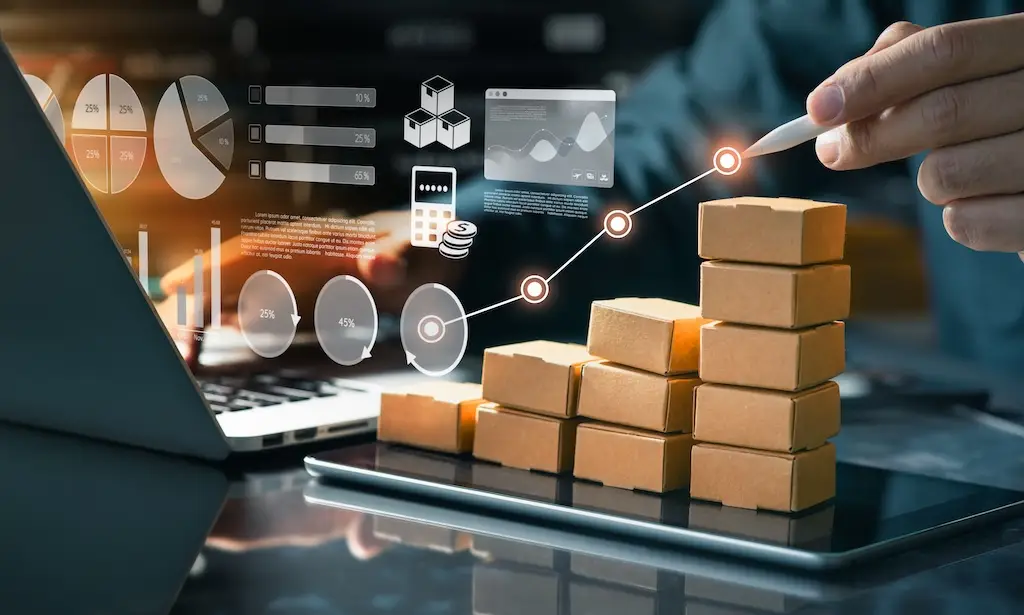Sell through rate shows how quickly you sell your inventory. It’s key for balancing stock and meeting demand. Understanding it helps prevent overstocking and understocking, boosting profits. This article covers what sell through rate is, how to calculate it, and ways to improve it.
Key Takeaways
- The sell-through rate measures how quickly inventory sells, helping businesses manage stock effectively and aligning supply with customer demand.
- Calculation of the sell-through rate involves precise data collection: (units sold / units received) x 100, ensuring accurate insights into product performance.
- Improving sell-through rates requires targeted marketing, efficient inventory management, and strategic promotions to enhance sales and optimize inventory levels.
Understanding Sell Through Rate
The sell-through rate measures the quantity of inventory sold in a particular time frame. It is calculated in relation to the amount of inventory received. Put simply, it reveals how fast your stock is moving. This metric is key as it highlights product performance and whether your inventory levels match customer demand. For instance, if you receive 100 units of a product and sell 80 units within a month, your sell-through rate is 80%, which is considered quite good.
A high sell-through rate is crucial for effective inventory management and healthy cash flow. It prevents overstocking, which can cause financial losses and wasted storage space. On the other hand, a low sell-through rate suggests inventory isn’t moving as expected, pointing to possible issues with pricing, marketing, or product appeal.
Regularly tracking your sell-through rate helps make informed purchasing decisions, ensuring you have the right amount of stock to meet customer demand without overstocking or stockouts. Mastering this balancing act can significantly boost sales performance and overall profitability.
How to Calculate Sell Through Rate
The sell-through rate formula is simple but calculating it requires precise data collection. Use this formula: (number of units sold / number of units received) x 100. This gives you a percentage that represents how much of your inventory has been sold over a given period.
Accurate calculation requires reliable sales data and a platform to capture it. The critical pieces of information are the number of units sold and the quantity of stock received. For example, if you received 200 units of a product and sold 150 units, your company’s sell through rate would be (150/200) x 100 = 75%.
Include only the inventory received in the calculation, not the total stock on hand. This ensures the rate accurately reflects the performance of the inventory received during the analyzed period.
Example Calculation
Let’s illustrate the calculation with a real-life scenario. Suppose you run a bakery and in September, you received 300 cupcakes and sold 240 of them. To calculate the sell-through rate, you would use the formula: (240/300) x 100 = 80%. This means that 80% of the cupcakes you received in September were sold within the same period.
This step-by-step calculation illustrates the practical application of the sell-through rate formula, guiding inventory management decisions. Regular calculation and analysis of this rate enable effective inventory management and prompt response to customer demand.
Importance of a Good Sell Through Rate
A good sell-through rate is a critical indicator of your business’s health. Expressed as a percentage, it provides clarity on how well your inventory is performing. A high sell-through rate signifies that you are accurately predicting customer demand, which enhances profitability by ensuring that you have enough inventory to meet sales without excess.
Efficient inventory management driven by a good sell-through rate helps avoid the financial pitfalls of overstocking and understocking. Overstocking ties up capital and increases storage costs, while understocking leads to missed sales opportunities and dissatisfied customers. Maintaining an optimal sell-through rate ensures healthy cash flow and better profit margins.
Additionally, measuring sell-through rates aids in making informed purchasing decisions. It ensures ordering sufficient quantities to meet demand without excess, leading to a more efficient balance between sales and inventory levels. This balance is crucial for maintaining a competitive edge in the market.
Factors Affecting Sell Through Rates
Various factors, both internal and external, influence sell-through rates. Internal factors include pricing strategies and inventory practices, while external factors encompass market trends and consumer behavior. Understanding these factors is essential to optimize your sell-through rates and improve overall sales performance.
Effective pricing strategies and consistent inventory management provide insights into product popularity, assisting in making informed decisions. Conversely, overstocking often results from poor demand forecasts, leading to excess inventory and negatively impacting sell-through rates.
These rates can vary across retail categories and change over time due to shifts in consumer behavior.
Pricing Strategies
Adjusting pricing strategies can significantly influence sell-through rates. Discounting products can boost sales, but it might also lower profit margins. Bundling products has been shown to improve sell-through rates by increasing perceived value. Setting prices that align with fair market value can encourage higher sales and improved sell-through rates.
However, striking a balance is important. Offering low prices may increase sell-through rates but can also lead to potential revenue loss. Effective pricing strategies play a crucial role in overall sales performance and maintaining a good sell-through rate.
Market Trends
Staying updated with market trends is key for forecasting demand and optimizing sell-through rates. Market trends offer valuable insight into consumer preferences and buying patterns, directly influencing sell-through rates. For example, a spike in demand for eco-friendly products could lead to a higher sell-through rate for sustainable goods.
Managing inventory in line with market trends is key for meeting customer demand. Insufficient inventory visibility can lead to stock mismanagement, affecting sell-through rates. Aligning inventory strategies with market trends helps achieve better sell-through rates and avoid unsold inventory.
Supply Chain Management
Effective supply chain management ensures inventory levels meet customer demand and prevents stockouts. Supply chain issues, such as unexpected delays and bottlenecks, can significantly disrupt sell-through rates. Monthly monitoring of sell-through rates helps identify trends and inconsistencies, enabling timely adjustments in inventory management.
Inventory management software aids in accurately forecasting demand and managing stock orders to align inventory with customer needs. Real-time inventory data management helps prevent stockouts and overstocking, supporting better sell-through rates.
Effective supply chain practices are crucial for maintaining a high sell-through rate and ensuring customer satisfaction.
Strategies to Improve Sell Through Rate
Improving sell-through rates involves targeted marketing efforts, efficient inventory management, and strategic promotional activities. Tracking sell-through rates allows businesses to identify trends and adjust strategies to better align with customer preferences.
Effective data tracking and analysis reveal underlying issues causing low sell-through rates, allowing businesses to address them strategically. Implementing these strategies can significantly enhance sell-through rates and overall sales performance.
Enhanced Marketing Efforts
Investing in marketing and promotion drives traffic to your store and boosts sell-through rates. Higher promotion leads to increased sales and better sell-through rates. Understanding customer demographics and preferences helps businesses effectively target marketing efforts to increase visibility and sales.
Collaborating with retailers, using social media, and partnering with influencers can further increase visibility and drive sales. Increase marketing efforts during seasonal demand changes to maintain inventory movement. Neglecting strategic product promotion can result in missed sales opportunities.
Inventory Management Software and Warehouse Management Systems
Both Inventory Management Software and Warehouse Management Systems (WMS) are crucial tools for businesses aiming to optimize sell-through rates and streamline operations. These solutions provide real-time visibility into inventory levels, ensuring businesses can track stock movement, monitor sell-through rates, and avoid issues like overstocking or stockouts.
While inventory management software focuses on tracking and analyzing stock levels, WMS goes a step further by managing the physical storage, picking, and packing processes. By integrating these systems with your business operations, you can achieve a more comprehensive approach to inventory control, from accurate forecasting and automated reordering to efficient order fulfillment and shipping.
Advanced features such as analytics dashboards, bundling capabilities, and demand forecasting empower businesses to make data-driven decisions and maintain healthy sell-through rates. Seamless integration with ERP and POS systems ensures centralized data management, enhancing efficiency across the supply chain.
Promotional Activities
Offering promotions and discounts enhances sales and improves sell-through rates. Product bundling, where items are sold at a discounted price, can incentivize purchases and improve sell-through rates. Implementing offers or promotions effectively moves stagnant stock.
However, discounts reduce profit margins and should be applied sparingly. Including deadstock as free gifts with orders can encourage purchases and improve sell-through rates. Sell-through rate can indicate the success of a promotional campaign by reflecting how well it drives purchases.
Sell Through Rate vs Inventory Turnover
Sell-through rate and inventory turnover are both essential metrics for inventory management but serve different purposes. Sell-through rate focuses on the quantity sold during a particular time frame, while inventory turnover assesses how quickly products are fully sold. Both metrics are crucial for making informed reorder and purchasing decisions.
When it’s crucial to keep popular items in stock, focusing on the sell-through rate is more important. Promotions can enhance inventory turnover, generate cash flow, and effectively manage excess stock. Tracking sell-through rate helps businesses make better storage, inventory, sales, and merchandising decisions.
A small business may track sell-through rate instead of inventory turnover to understand how quickly they are selling products. Both metrics provide valuable insights into inventory management and overall sales performance.
Common Mistakes Impacting Sell Through Rate
Many businesses struggle with sell-through rates due to common mistakes in inventory and demand management. Overordering before understanding actual sales leads to poor inventory management and excess inventory, resulting in too much inventory. Overstocking results in high storage costs and risks of stock expiration, directly impacting cash flow and profitability.
Proper demand forecasting is essential to avoid these issues. Failing to accurately predict customer demand results in excess inventory and missed sales opportunities. Avoiding these common mistakes helps businesses maintain a healthier sell-through rate and improve overall sales performance.
Case Study: Improving Sell Through Rates
Let’s take a look at a real-life example. A newsagency improved its sell-through rate by implementing a new POS system to track sales data and customer purchasing patterns. This led to reduced stock and improved cash flow. Similarly, a fruit and vegetable store adopted a minimum/maximum stock control system, adjusting orders based on real-time sales, achieving a sell-through rate consistently above 70%.
Creative merchandising, such as optimizing store layouts and utilizing seasonal trends, can significantly enhance sell-through rates for underperforming products. Running promotions or bundling slow-moving items with popular ones can incentivize purchases and improve overall inventory turnover.
In a competitive retail environment, brands increasingly focus on improving their sell-through rates to maximize profitability and manage inventory effectively. Implementing these strategies helps businesses see significant improvements in their sell-through rates and overall sales performance.
Why Choose Comparatio to Optimize Your Sell-Through Rates?
When it comes to improving your sell-through rates, data accuracy and efficient processes are non-negotiable. That’s where Comparatio steps in. We specialize in Electronic Data Interchange (EDI) solutions that seamlessly connect your business systems, enabling you to gather, analyze, and act on inventory data in real time.
Here’s how Comparatio can help:
- Streamlined Data Integration: Eliminate manual data errors by automating your inventory and sales data exchanges with suppliers and retailers.
- Actionable Insights: Gain access to detailed analytics, helping you track sell-through rates, forecast demand, and optimize inventory levels.
- Improved Collaboration: Ensure alignment across your supply chain by seamlessly sharing sell-through rate data with your partners, enabling faster and smarter decision-making.
- Scalable Solutions: Whether you’re a small business or an enterprise, Comparatio offers tailored EDI solutions that grow with your business.
By leveraging Comparatio’s expertise, you can not only master the sell-through rate formula but also create a system that supports long-term growth and profitability.
Ready to optimize your inventory management? Contact Comparatio today to learn how we can transform your operations and boost your bottom line.
Summary
Mastering the sell-through rate formula is essential for improving inventory management and boosting sales. By accurately calculating sell-through rates, businesses can align inventory levels with customer demand, avoiding the costly pitfalls of overstocking or understocking.
Effective strategies, including optimized pricing, market trend analysis, and the use of inventory management tools or WMS, help businesses achieve better sell-through rates. Leveraging actionable insights and seamless data integration, as offered by Comparatio, ensures smarter decision-making and improved collaboration across the supply chain.
By addressing common challenges and implementing these solutions, businesses can enhance profitability and stay competitive. With the right tools and strategies, your sell-through rate can become a cornerstone of your success.
Take control of your sell-through rates with Comparatio’s EDI solutions. From automating data exchanges to providing actionable insights, we help you streamline operations and maximize profitability. Contact us today to see how Comparatio can optimize your inventory management and drive long-term growth.
Frequently Asked Questions
How do you calculate sell through rate?
To calculate the sell-through rate, simply divide the number of units sold by the number of units received, then multiply by 100. This gives you the percentage of your inventory that has been sold.
Why is a high sell-through rate important?
A high sell-through rate is crucial because it reflects efficient inventory management, helping you avoid costly overstocking and understocking while maximizing sales opportunities. Ultimately, it keeps your business profitable and responsive to customer demand.
How can market trends affect sell-through rates?
Market trends directly impact sell-through rates by revealing consumer preferences and buying behaviors. Keeping an eye on these trends allows businesses to anticipate demand and adjust strategies to boost sales.
What are some common mistakes that impact sell-through rates?
One major mistake is overordering without grasping real sales trends, which can result in excess inventory and lost sales. Staying on top of demand forecasting and adjusting inventory based on actual sales data is key to improving sell-through rates.
How can promotional activities improve sell-through rates?
Promotional activities like discounts and product bundling can significantly boost sell-through rates by encouraging customers to make purchases. This strategy not only moves stagnant inventory but also enhances overall sales performance.






